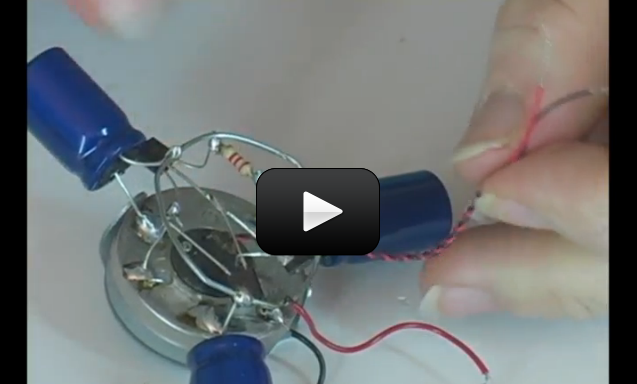This project is for advanced students.This is one of the coolest applications of renewable energy to come about in recent years. BEAM stands for Biology, Electronics, Aesthetics, and Mechanics. It basically refers to a class of robots that instead of having complicated brains, rely on nervous-system type of sensors to interact with their world.
Some BEAM robots skitter, dance, flash, jump, roll, or walk, and most are solar powered. The result is a fast responding robot made of old cell phone parts that can fit inside your hand. We’ll be making a few different types so you can get a good handle on this type of programming-free, battery-free robotics.
Most BEAM robots use the same solar ‘engine’. The solar cell will convert sunlight into electricity, which will then be stored in our capacitors (think ‘electricity tanks’) until a certain threshold is reached… when the tanks are full, the robot begins to move. This means that you can leave them out all day, and they will sit and collect energy, then turn on by themselves until they run out of juice, then turn off, sit and recharge until they have enough energy to go again… and off they go!
Let’s walk through how to make a BEAM robot. Once you’ve got the hang of it, make a second solar engine from the rest of your parts and add any kind of body you want!
[am4show have=’p9;p49;p108;p103;’ guest_error=’Guest error message’ user_error=’User error message’ ]
You’ll need to get the following materials:
- Tiny eccentric motor
- Vibrating disk motor
- Two 2.2k-Ohm resistors
- Six 4700 uf electrolytic capacitors
- Two PNP 3906 transistors
- Twp NPN 3904 transistors
- Two voltage triggers
- Two 37x33mm solar cells from Solarbotics
- Paper clips (a few of each: small and large)
- Hot glue gun, soldering iron with solder, electrical tape
- Pliers, wire cutters, diagonal cutters (if you have them)
Here’s what you do…
Beam Robot:
[/am4show]


You can request special access to a unit early if you like. Just send us an email so I can forward it to the right person who can adjust your account.
Why dosen’t it show that I have acsess to Unit 12?
Don’t worry too much about the actual size – that’s going to vary a lot by manufacturer. I just wanted you to see that the ones for the beam robots are a lot bigger than the usual ones you’d see at Radio Shack. The voltage rating should be at least 10 volts.
If you have ten of those, connect 10 of them in series to get one 4700 cap – but you’ll also need to do that two more times to get the required three 4700 caps, and by then your robot will be too heavy. Here’s a cheap source to get it from at Jameco.
You know what never mind i asked my own question after i reread what you wrote 🙂
im sorry 1.5 cm and 1 cm in dia
im all confused today
the capacitor it self in smaller than the one you said to buy.
it is about 1.5 inches tall and 1 inch in dia.
and rayed 470 micro farads at 25 volts
well it acually is 470 micro F but i dont know how to write that symbol on the computer
It’s actually the letter in front of the “f” that tells you what the size of the number is. Like 3 mm means 0.003 meters, and 3 nm means 0.000000003 meters, you have the same thing going on with the “f” (which means farads).
So, which is the bigger number, 3 meters or 6 mm?
If you convert mm to meters, you get this:
3 m or 0.006 meters?
So the larger number is 3 meters, right?
In the capacitor case you asked about, the 4700μf is the larger number.
470pf is really this: 0.000000000470f and
4700μf is this: 0.004700f
So can you see which ones is bigger?
Just a note – the 4700 caps are as big around as a tube of lipstick, and the pf caps are usually no thicker than a skinny pencil. You’ll see the actual sizes of these parts in the video. And yes, by all means use whatever you have in your drawers before buying any more parts. You can always add caps together in parallel to get their numbers to add up, but you’d need a LOT of the pf caps to get to the μf range. Does that help?
For reference:
m (milli) means 10-3
μ (micro) means 10-6
n (nano) means 10-9
p (pico) means 10-12
Ok i get it now so bigger the number smaller capacity !?
then 470pf is propable too big than or no ???
im just trying to use the stuff i already have in my “electronic junk door”
Thanks
The 6800pf capacitor is actually too small – here’s the actual numbers for each value written out:
6800pf = 0.000000006800f
4700μf = 0.004700f
You want your caps to be as large as possible to store as much charge as possible, or your robot won’t run at all.
will a 6800 pf capacitor work or is that too high ???